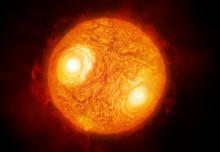Listen to today's episode of StarDate on the web the same day it airs in high-quality streaming audio without any extra ads or announcements. Choose a $8 one-month pass, or listen every day for a year for just $30.
You are here
Moon and Antares
Stars follow a life-long weight-loss program. They blow charged particles off their surfaces. Over time, the amount of material in these “winds” can add up. Some of the heavier stars, in fact, can expel enough material to make several stars as massive as the Sun.
An example is Antares, the leading light of the celestial scorpion. It’s in good view tonight, to the right of the full Moon as darkness falls.
Antares is a supergiant — one of the biggest and brightest stars in the galaxy. It’s about 12 times the Sun’s mass, and big enough that if you placed it at the center of the solar system, it would extend past the orbit of Mars.
But when Antares was born, about 11 million years ago, it was even heavier. Studies in recent years have placed its initial mass at about 15 to 17 times the mass of the Sun. The difference has been blown out into space on the star’s winds.
Antares has lost so much of its original weight because it was heavy to begin with. Massive stars “burn” through their nuclear fuel quickly, making their cores extremely hot. Radiation from the core of such a star causes its outer layers to puff outward. That far from the core, the surface gravity is relatively low, so it’s easy for radiation to push hot gas out into space.
Antares is fated to expel even more of its mass. At the end of its life, its core will collapse, causing its outer layers to explode as a supernova — blasting most of its remaining gas out into the galaxy.
Script by Damond Benningfield




